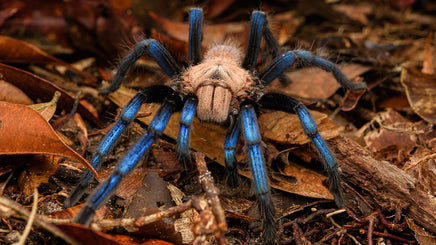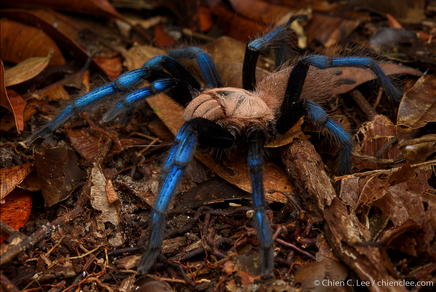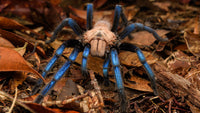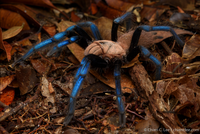Introducing the Birupes simoroxigorum, a recent and fascinating addition to the tarantula world. Known as the Blue Tarantula, this species is gaining attention for its stunningly vibrant blue coloration, which is rare and highly sought after among enthusiasts. Native to Malaysia, the Birupes simoroxigorum is an arboreal species that showcases the incredible diversity and beauty found in tarantulas. Its unique appearance and mysterious nature make it a prized specimen in any collection.
Care Details:
-
Temperature: The ideal temperature range for Birupes simoroxigorum is between 75 to 85°F (24 to 29°C). A warmer environment encourages active eating, faster growth, and more frequent molting, which is quite manageable for these species.
-
Humidity: This species thrives best at a humidity level of about 70-80%. As with other species, water dishes are not necessary, but they don't pose any harm. I personally opt not to use them.
-
Housing: Being an fossorial species, the Birupes simoroxigorum requires vertical space. For babies, a small vial about 5 inches tall and 2 inches in diameter with ventilation is perfect. I provide these vials free at checkout upon request. For juveniles larger than 2 inches, a 7-8 inch tall enclosure is suitable, and adults require 12 to 16 inches of vertical space.
-
Diet: My Blue Tarantulas enjoy a varied diet of crickets and cockroaches, including Dubia and Red-runner roaches. For juveniles and adults, regular-sized prey is ideal, while baby tarantulas need smaller prey. If the prey is too large, crushing the head before offering it to the tarantula is effective. Always remove uneaten food to prevent mold. An occasional pinky or hopper mouse adds diversity to their diet, but remember, these should be treats and not regular meals.
In-depth Facts:
- Latin Name: Birupes simoroxigorum
- Common Names: Bornean Neon Blueleg Tarantula
- Locale: Originating from Malaysia.
- Category: Fossorial. They create intricate webs in their enclosures.
- Size: They can grow to have a leg span of up to 6 inches.
- Urticating Hairs: Birupes simoroxigorum does not possess urticating hairs.
- Growth Rate: They have a moderate growth rate.
- Life Span: The expected lifespan is still being studied, but like most tarantulas, females tend to live longer than males.
- Recommended Levels: Everyone is welcome.
Stay Connected:
- Instagram: Follow my Instagram, I'm most active here.
- YouTube: For care and education videos, check out my YouTube channel.
- Facebook: Over here I have all my reviews.
- TikTok: Visit my TikTok for additional content.
Safety Disclaimer:
Experiencing a tarantula bite is an extremely rare occurrence, and it's important to note that there have been no recorded fatalities due to a tarantula bite. The venom potency varies across species, with Old World tarantulas generally having stronger venom than their New World counterparts.
It's crucial to approach tarantulas with respect and understanding. If you happen to get bitten, which is unlikely, the key is to stay calm. In most cases, the discomfort is superficial and subsides within a few minutes to a few hours. However, bites from species with more potent venom may result in symptoms lasting up to a week. Remember, larger tarantulas tend to have more venom than smaller ones.
Please be aware that I cannot assume responsibility for bites. Tarantula handling should be done at your own risk. In my 11 years of experience with these creatures, I have only been bitten once, by a species with highly potent venom. While the experience was painful, the symptoms had completely disappeared after a week.
Handle tarantulas responsibly, and always prioritize your safety and the well-being of the tarantula.



